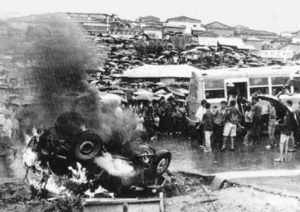 |
|
Those displaced to Seongnam in 1971 under the government's policy staged a massive protest.
|
The cheapest rooms in shantytowns offer little light, hope
A scooter zips down an alley just next to a small, low-set window, making a cacophany as the sound of its exhaust echoes off the narrowly spaced concrete walls. For Mr. Jo, 57, a resident of Seongnam, Gyeonggi Province, this deafening noise has been commonplace for more than a decade. The small window is his: he has lived in half-basement rooms in Sanseong-dong, Sujeong-gu, Seongnam for over 10 years. Perhaps due to the dampness that seeps into his bedclothes and the mold that grows in the room, he suffers from a skin condition on his neck and his head never feels clear. "If you want to find two rooms requiring only a 10-million-won (US$10,000) deposit and 120,000 won monthly rent, you have to ’go underground,’ " said Jo. Jo is not the only one in this situation. Up to 21 percent, or 18,000 out of 90,000 households in Sujeong-gu live in underground rooms. The same is true for about 18 percent, or 15,000 households out of the 86,000 total households in neighboring Jungwon-gu. This means that one in five families here lives in underground rooms.In 1971, these poor living conditions began in the area when poor urban dwellers in central Seoul were driven out of their homes by Park Chung-hee’s dictatorial regime in his breakneck drive to develop the capital. Kim Jong-hae, 65, who moved here in the 1970s following the mass exodus of poor from central Seoul, said, "In the 1980s, makeshift construction combining two or three shanties began, and in order to make a lot of rooms in a small area of land, they built as many underground rooms and rooms built on roofs as possible." These rooms were - and still are - occupied by low-income earners driven out of other urban areas. The areas around Sujeong-gu and Jungwon-gu, with their shabby houses in clusters along steep mountain slopes - are in stark contrast with nearby Bundang-gu, lined with expensive apartments. About 1.6 million people across South Korea are living in half-underground rooms or makeshift rooftop rooms. According to data on the 2005 census and housing provided by the National Statistical Office (NSO), nearly 586,000 households, or 1.42 million people, are living in underground rooms, while 51,000 households, or 87,000 persons, live in rooms on roofs and 45,000 households, or 110,000 persons, live in shanties and makeshift houses of plastic and other materials. Almost 93 percent of such people live in metropolitan areas surrounding Seoul. In the capital itself, 10.7 percent, or 355,000 households out of the city’s population, live in underground spaces. About 85 percent of persons living in underground residences and 93 percent of those living in rooftop rooms do not own their residence. Rep. Sim Sang-jeung of the opposition Democratic Labor Party (DLP) said, "Housing supply [surpassed demand] last year, but such a situation is attributed to [high-priced] real-estate polarization and a shortage of public housing. The government should urgently prepare measures so that the public housing can be fairly provided to those who need it."





